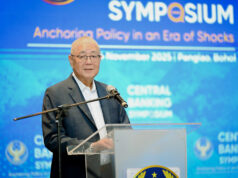Euro bond road shows completed this week
THE GOVERNMENT plans to determine next week when to price its planned benchmark-sized euro-denominated notes, after getting feedback from institutional investors in Europe at road shows that end this week, the Bureau of the Treasury (BTr) said.
“For this week, we will round up the deal road shows. Of course we’re going to several cities. And then next week, we will decide when to price,” Deputy Treasurer Erwin D. Sta. Ana told reporters Monday following the weekly Treasury bills auction.
Last week, the Philippines hired banks to arrange investor meetings in Europe to draw investor interest in its planned euro bond sale. The deal road show was held in Zurich, London, Paris, Frankfurt and Milan starting April 26. Deutsche Bank and UBS were tapped as joint global coordinators. The banks will also act as bookrunners alongside BNP Paribas, Credit Suisse and Standard Chartered.
Fitch Ratings and S&P Global Ratings last week assigned a “BBB” rating while Moody’s Investors Service on Monday assigned “Baa2” to the planned debt notes, all a notch above minimum investment grade, in line with the Philippines’ sovereign credit score.
Mr. Sta. Ana said the notes’ tenor will depend on investor feedback.
The government plans to issue “benchmark-sized” bonds in euros, meaning at least $500 million in size. However, the deputy treasurer said the government can “actually go over $500 million if it’s advantageous for us.”
“Actually, we’ve been planning to go back to the euro market for the longest time. This is part of the DoF (Department of Finance) and Treasury’s strategy to diversify its financial instruments and… investors base,” Mr. Sta. Ana said.
“We talk about the (US) Fed[eral Reserve] reportedly not raising interest rate anytime soon so that has an effect on rates globally. We feel that it’s something that we can actually handle with respect to the pricing in the euro market current levels.”
The state plans to borrow P1.189 trillion this year — 75% of which will be sourced domestically while the remainder will be from foreign creditors — to fund a budget deficit programmed at P624.4 trillion, equivalent to 3.2% of gross domestic product, and support increased government spending programmed at P3.774 trillion.
“We actually put ourselves in a position where we can… make the necessary preparations, get the necessary approvals so that when the opportunity comes, we can trigger a transaction,” Mr. Sta. Ana added.
The last time the government borrowed euros was in 2010, raising €75 million in three- and five-year multi-currency retail Treasury bonds that also raised $400 million. It also raised €500 million in 10-year debt in 2006 in a multi-currency global bond offer along with $1.5 billion.
The government is also preparing to raise 6 billion yuan ($893.3 million) this year from issuing so-called “panda” bonds from the China market, its second of such an offering. However, the BTr is still ironing out regulatory approvals here and in China.
“The PBoC (People’s Bank of China), we got that one already, and the process is that the PBoC will be submitting it to NAFMII (National Association of Financial Market Institutional Investors) so that NAFMII can give us the final go ahead.”
Apart from “panda” notes, the government is also looking at offering “samurai” bonds amounting to $1-1.5 billion in yen equivalent some time next semester.
In January, the Philippines sold $1.5 billion in 10-year offshore dollar bonds, priced 110 basis points (bp) above benchmark US treasuries and tighter than an initial 130 bps guidance. — Karl Angelo N. Vidal



